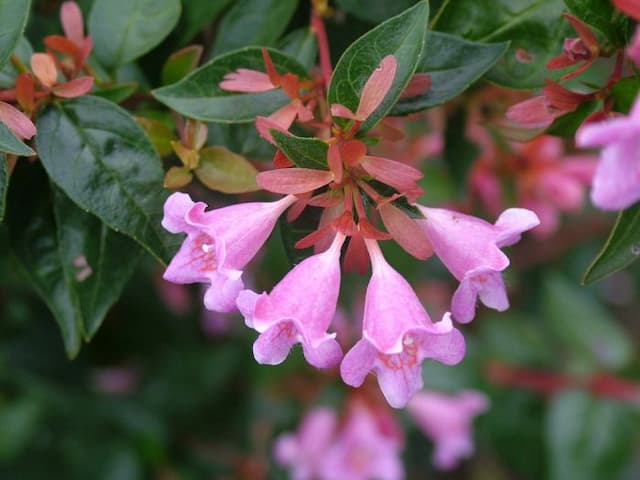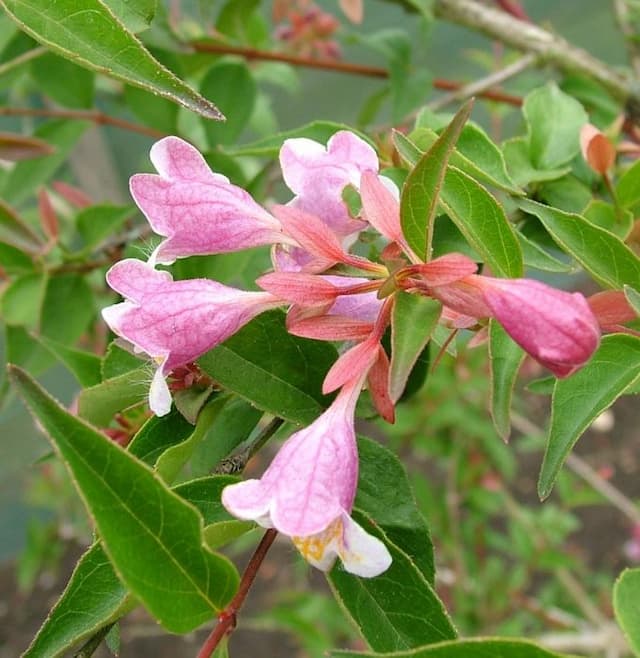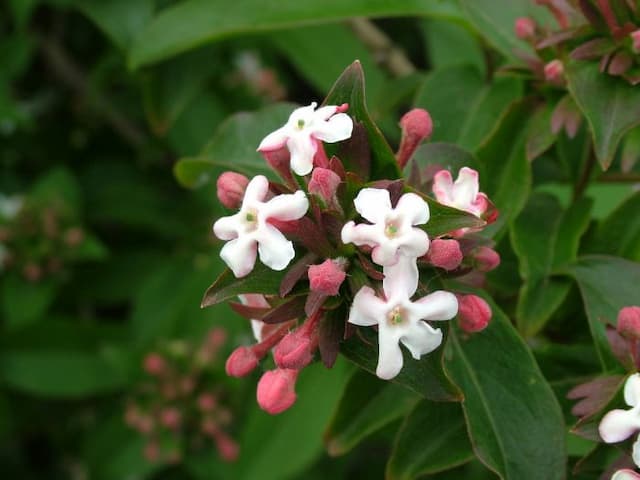Variegated Weigela Weigela 'Florida Variegata' (v)

ABOUT
Weigela 'Florida Variegata', commonly known as variegated weigela, is a visually striking shrub known for its beautiful foliage and attractive flowers. The leaves of the variegated weigela are particularly distinctive, with a creamy white or pale yellow margin surrounding a green center, giving the plant a bright and lively appearance. The variegation adds a splash of color to garden spaces even when the plant is not in bloom. During the blooming season, the variegated weigela produces an abundance of trumpet-shaped flowers. These blooms are typically a soft pink to rosy-pink hue, which contrasts elegantly with the variegated leaves. The flowers are arranged in clusters, creating a lush and full display that can attract pollinators such as bees and butterflies to the garden. As a deciduous shrub, the variegated weigela will shed its leaves in the fall, but not before showing a delightful autumn color change where the foliage may turn to shades of yellow or red. The branches of the plant tend to arch gracefully, adding to its ornamental appeal. Though varying in mature size, the variegated weigela generally maintains a dense, rounded form that contributes to its use as a decorative element in landscapes.
About this plant
 Names
NamesFamily
Caprifoliaceae
Synonyms
Variegated Weigela, Variegated Florida Weigela
Common names
Weigela florida 'Variegata'.
 Toxicity
ToxicityTo humans
Weigela is not considered toxic to humans. There are no well-documented cases of poisoning from ingestion of Weigela plants. Therefore, if the plant were ingested, it is unlikely to cause any significant symptoms or lasting consequences.
To pets
Weigela is also not known to be toxic to pets. It is generally considered a safe plant for gardens and outdoor areas where pets may roam and explore. If a pet were to ingest parts of a Weigela plant, they are not typically expected to experience symptoms of poisoning or suffer adverse health effects as a result.
 Characteristics
CharacteristicsLife cycle
Perennials
Foliage type
Deciduous
Color of leaves
Variegated
Flower color
Pink
Height
4-6 feet (1.2-1.8 meters)
Spread
4-6 feet (1.2-1.8 meters)
Plant type
Shrub
Hardiness zones
4-8
Native area
Asia
Benefits
 General Benefits
General Benefits- Attractive Foliage: The plant features variegated leaves, adding a splash of color to the garden throughout the season.
- Showy Flowers: It blooms with pink to red trumpet-shaped flowers in late spring to early summer, attracting pollinators.
- Low Maintenance: This shrub requires minimal upkeep once established and is relatively disease and pest-resistant.
- Versatility in Landscaping: Weigela can be used in mixed borders, as a standalone specimen, or for mass plantings.
- Tolerates Various Soil Types: It can adapt to a range of soil conditions, although it prefers well-drained soils.
- Deer Resistant: The plant is not preferred by deer, which makes it suitable for gardens in areas with high deer populations.
- Attracts Wildlife: The flowers provide nectar for hummingbirds and butterflies, adding wildlife interest to the garden.
- Seasonal Interest: With its spring flowers and autumn leaf color changes, Weigela offers multiple seasons of visual interest.
 Medical Properties
Medical PropertiesThis plant is not used for medical purposes.
 Air-purifying Qualities
Air-purifying QualitiesThis plant is not specifically known for air purifying qualities.
 Other Uses
Other Uses- Weigela 'Florida Variegata' can be used as a natural barrier or hedge when planted in a row, providing privacy and reducing noise pollution.
- The plant makes an excellent backdrop for garden vignettes, enhancing the appearance of other colorful perennials in front.
- Its branches can be used in floral arrangements, adding both foliage and flowers to bouquets or indoor displays.
- Weigela can be trained to grow over arbors or trellises, providing a beautiful and living architectural feature.
- The plant's dense foliage offers shelter and nesting sites for small birds, supporting local wildlife.
- Due to its interesting leaf variegation, Weigela can be used in educational gardens to demonstrate variegation patterns to students and enthusiasts.
- Photographers and painters may use Weigela as a subject or backdrop due to its striking flowers and foliage, inspiring art and photography.
- In larger gardens or estates, Weigela can be used to line walkways, creating an inviting and colorful path for visitors.
- Its low-maintenance nature makes it an ideal candidate for urban greening projects, helping to beautify city spaces with little upkeep.
- Weigela 'Florida Variegata' can be planted in large pots or containers to decorate patios, balconies, or terraces, adding greenery to urban living spaces.
Interesting Facts
 Feng Shui
Feng ShuiThe Weigela is not used in Feng Shui practice.
 Zodiac Sign Compitability
Zodiac Sign CompitabilityThe Weigela is not used in astrology practice.
 Plant Symbolism
Plant Symbolism- Admiration: Weigela often symbolizes admiration due to its showy blossoms, expressing the beauty one sees in another.
- Grace: With its arching branches and soft-colored flowers, it symbolizes grace and elegance.
- Prosperity: The abundant and vigorous growth of Weigela can represent growth and prosperity in one's life.
- Endurance: The hardiness of this plant to various climates and conditions can symbolize the ability to endure challenges.
- Romantic Fervor: The plant is often associated with passionate feelings due to its profuse, vibrant spring blooms.
 Water
WaterVariegated Weigela should be watered regularly, especially during its first growing season to establish a deep, extensive root system. Once established, water the plant deeply, ensuring moisture reaches the roots, about once a week unless there are rains. During hot, dry periods, increase watering frequency to every few days. Each watering session should provide the plant with approximately 1 to 2 gallons of water, depending on the size of the plant and the soil conditions. It's crucial to avoid overwatering as Variegated Weigela does not like soggy soil.
 Light
LightVariegated Weigela thrives best in full sun to part shade. The ideal spot for this shrub is where it can receive at least 6 hours of sunlight each day, which helps encourage prolific flowering and maintains the vibrant colors of the leaves. However, it can also tolerate light shade, especially in hotter climates where some shelter from intense afternoon sun can be beneficial.
 Temperature
TemperatureVariegated Weigela is hardy and can tolerate a range of temperatures. It does best in a temperature range of 50°F to 75°F but can withstand winter temperatures as low as 20°F. It's important to plant Variegated Weigela in a location that is not prone to late spring frosts, as this can damage the flowers and buds. The shrub may survive up to a maximum temperature of around 90°F but may require additional watering in such conditions.
 Pruning
PruningPrune Variegated Weigela immediately after it finishes blooming, typically in late spring or early summer, to maintain its shape and encourage new flower buds for the next season. As an overall practice, remove any dead or crossing branches and up to a third of the oldest stems to promote vigorous growth. Pruning every year ensures that the Weigela remains healthy and vibrant.
 Cleaning
CleaningAs needed
 Soil
SoilVariegated Weigela thrives in well-drained soil enriched with organic matter; a mix of loam, peat, and perlite works well. It prefers a slightly acidic to neutral pH, around 5.5 to 7.5.
 Repotting
RepottingVariegated Weigela, being a shrub, doesn't typically require repotting as it is usually planted directly in the ground. If in a container, repot every 2-3 years or when rootbound.
 Humidity & Misting
Humidity & MistingVariegated Weigela is adaptable to a range of humidity levels and does not require specific humidity conditions, making it versatile for various outdoor settings.
 Suitable locations
Suitable locationsIndoor
Provide bright light, prune to shape, ensure pot drainage.
Outdoor
Plant in sun or part-shade, well-drained soil, mulch base.
Hardiness zone
4-8 USDA
 Life cycle
Life cycleWeigela florida 'Variegata' starts its life cycle as a dormant cutting or as a seed, which germinates in spring under the right conditions of warmth and moisture. Once the seedling or cutting establishes roots, it enters a growth phase characterized by the development of variegated leaves—which are green with creamy edges—and a bushy form throughout the spring and summer. The plant then matures and enters the flowering stage in late spring to early summer, producing trumpet-shaped, pink flowers that attract pollinators. After flowering, some species may produce a small number of inedible fruit capsules containing seeds, but propagation is often achieved through cuttings. In autumn, Weigela 'Florida Variegata' begins to enter dormancy, with leaves changing color and eventually dropping. Finally, the plant endures winter dormancy until temperatures rise again in spring, which reinitiates the growth cycle.
 Propogation
PropogationPropogation time
Spring-Early Summer
The most popular method of propagating the Weigela 'Florida Variegata', commonly known as Variegated Weigela, is through softwood cuttings. This technique is best undertaken in late spring or early summer when new growth is mature enough to be firm yet flexible. To do this, select a healthy stem with new growth and snip a 4 to 6-inch (about 10 to 15 centimeters) cutting just below a leaf node. Remove the leaves from the lower half of the cutting to prevent moisture loss and dip the cut end into rooting hormone powder to encourage root development. Plant the cutting in a pot filled with a mixture of peat and perlite, ensuring at least two nodes are buried in the soil. The cutting should be kept in a warm, humid environment with indirect sunlight. After several weeks, roots will develop, and the cutting can be gradually acclimated to outdoor conditions before planting in the garden.








![Himalayan honeysuckle [Golden Lanterns]](/_next/image?url=https%3A%2F%2Fplants-admin.emdemapps.com%2Fimages%2Fplants%2F%2Fimages%2F604b55302cc87.png&w=640&q=75)
